| Author |
 Topic Topic  |
|
|
stewil
USA
139 Posts |
 Posted - 12/12/2010 : 21:07:49 Posted - 12/12/2010 : 21:07:49


|
My latest project is telling the "Story of Speed" and I hope I got it right. BTW - Corrections are appreciated if you notice any errors.
Some times I have visitors who express interest in the cars displayed in my office and the following is the story I tell them using some of model cars as the medium to the message.
The models were rather scattered around the room so with a new display case I was able to consolidate those important to the stories line.
Each car's caption helps tells the story.
Entrance to my office.

We're inside now looking north, each car seen has a story and we'll focus on a few of those models illustrating speed's evolutionary thread.
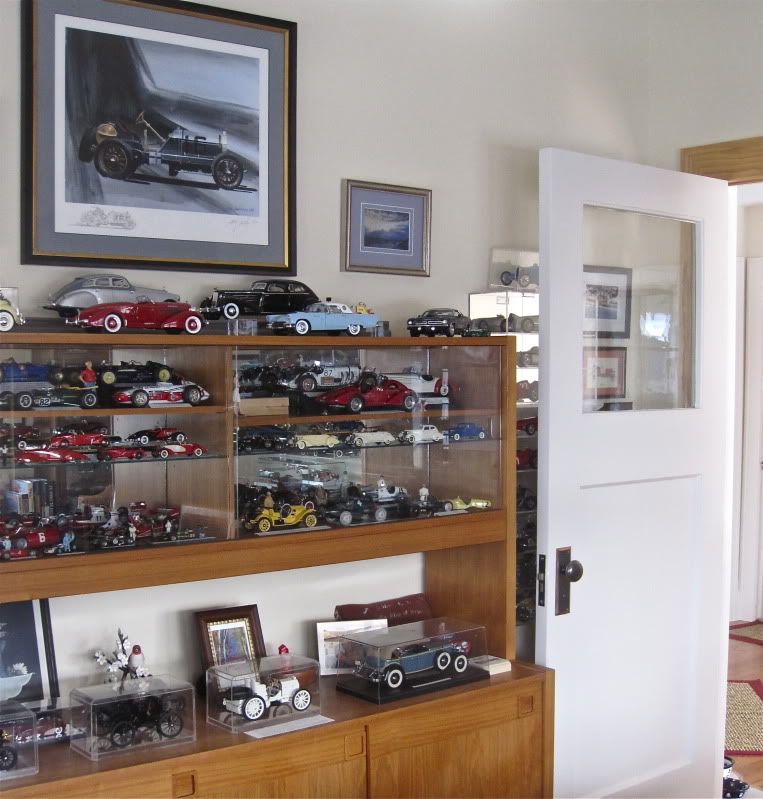
This is the theme of my entire collection.
Regardless of type, passenger or race car, every car has a story, every car is related, cars have evolved through time, and "Race Cars are . . . ".

This story begins with the 1st "modern" race car, still basically just a buggy framework underneath but with a specific architecture for attachments such as engine/gearbox/differential.
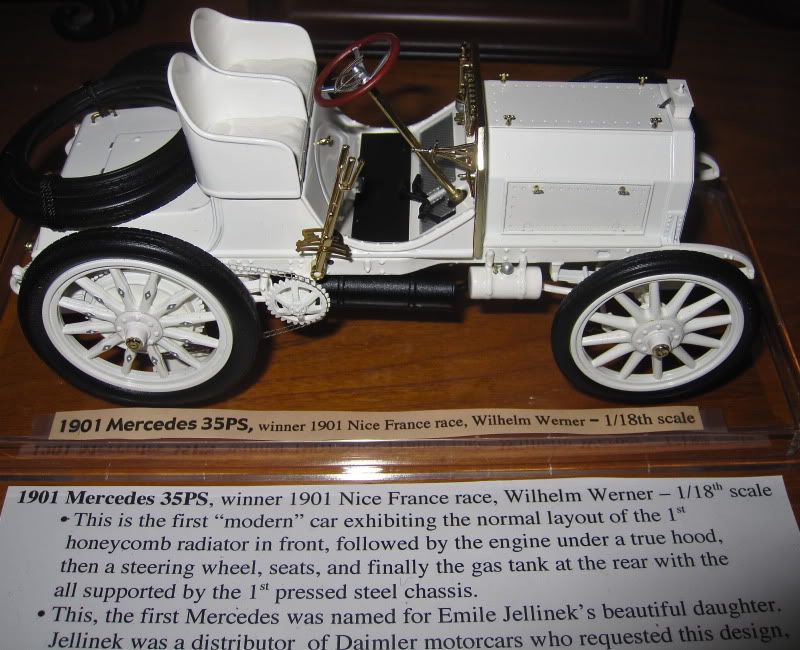
About 15 years elapse but the same basic layout remains. Fenders came and went as necessary when racing various venues in this era.

Another 10 years pass and there seems to be little change, there is but it is not earth shaking. That Miller is exquisitely sweet when one considers it's age.
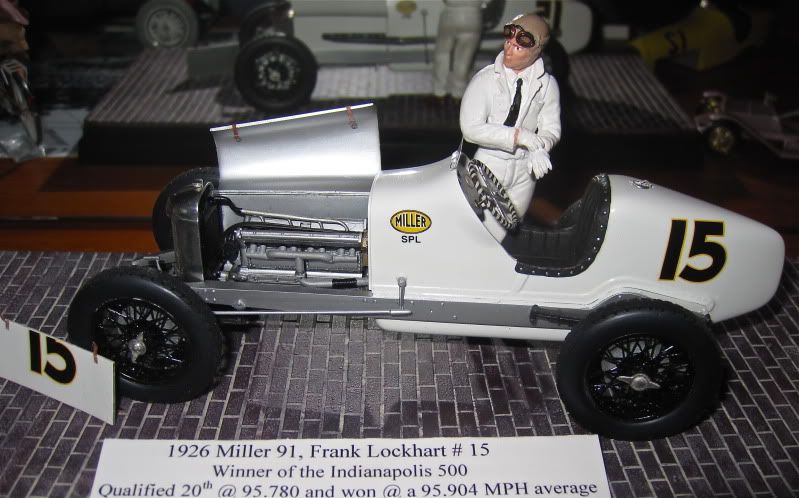
The story continues behind the door where I found room for another cabinet, YEA. Hence this story.
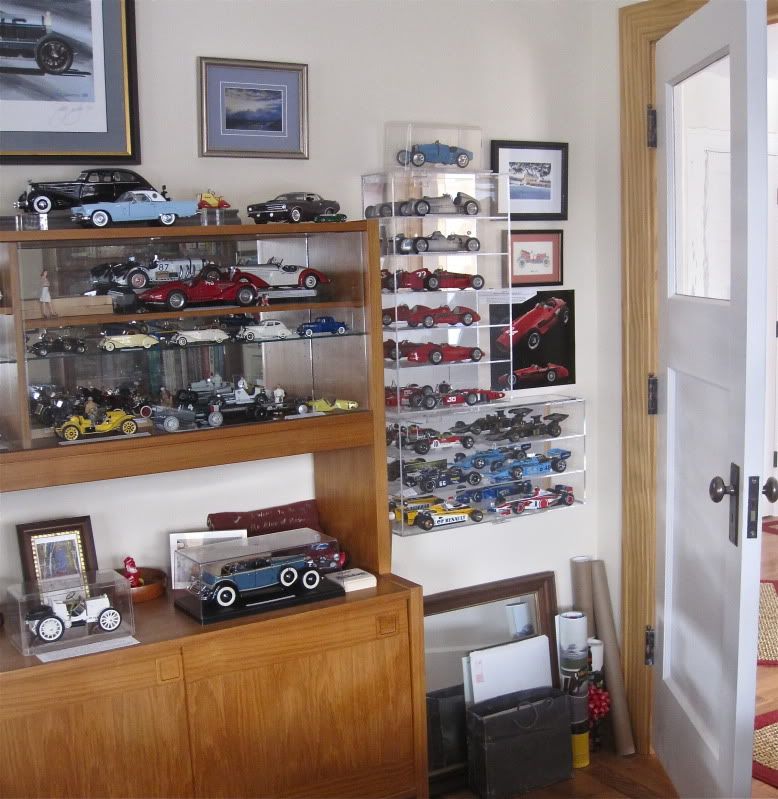
Some of the labels for the cars are hard to read but contain useful information, please do your best to read hem, sorry for the tiny wording.
The new display case.

From the top, The story continues with the Bugatti which is contemporary with the Miller seen in a photo above.

Another ten years pass and The Silver Arrows came onto the racing scene and utterly dominated it (about 1934).
The frame is still built using frame rails descended from how one built a wagon or a buggy, standard practice through the years.

The Alfa Romeo 158 'Alfetta' of 1938 and '39 was produced to compete in the 'voiturette' (small engined) class, it
preceded the Alfa 159 which is essentially the same car, though more powerful. The pre war 1.5 supercharged engine
fit right into the new F1 engine rules and was raced in 1950, the 159 raced in 1951. The 158 had an advanced steel tubular chassis
with aluminum body panels over it.
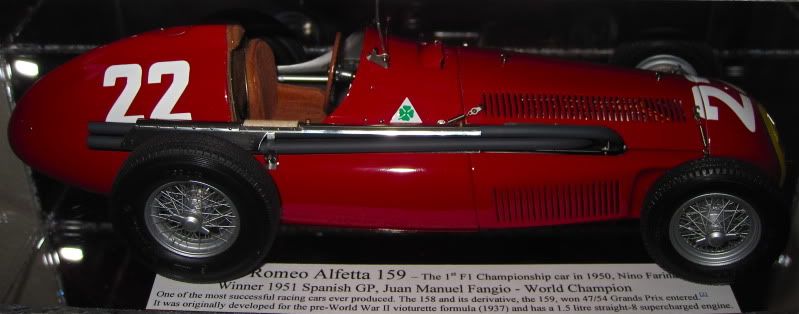
And here comes Ferrari with it's quite wonderful 4-Cyl DOHC engine in the F2 500 which won the championship in both 1952 and '53.

Then in 1954 along comes the acknowledged greatest F1 race car ever, The Maserati 250F.

Meanwhile at about the same time in the States another form of racing was playing out at the Indy 500, but the design principles were similar.
1958 was the last that front engined car carried a driver to the F1 Championship;

however, front engined cars remained competitive a little longer in the US than in Europe. This was the last Indy front engined winner, a real dinosaur.
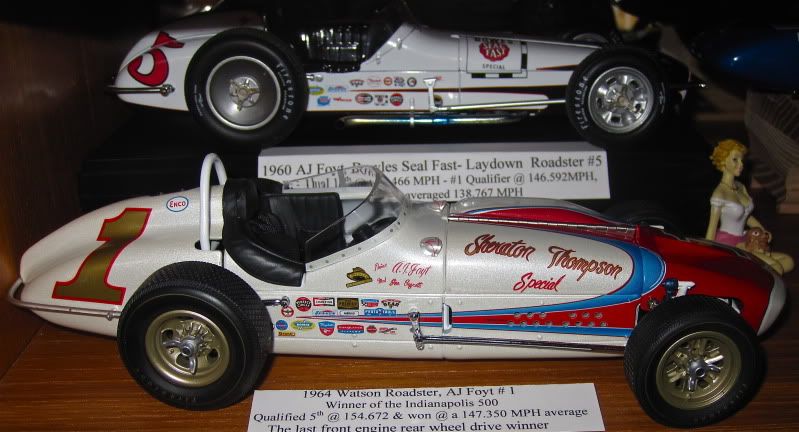
In 1965 Jim Clark and Lotus completely dominated the race and on that day the "dinosaurs" died.
Once again similar design principles were traded back and forth across the Atlantic as competitive race cars were again reasonably similar in design whether racing in F1 or at Indy.
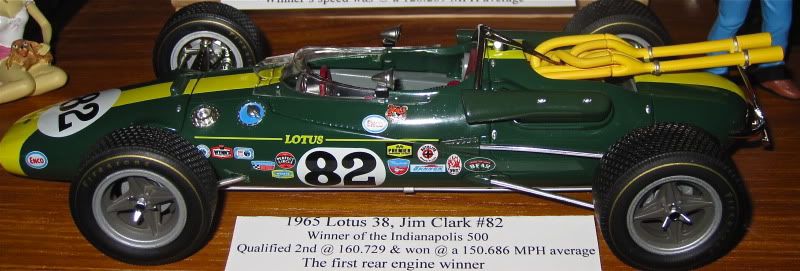
Stepping back a few years to 1961 in F1:
My favorite race car and the one that got me really interested in F1, the Sharknose Ferrari.
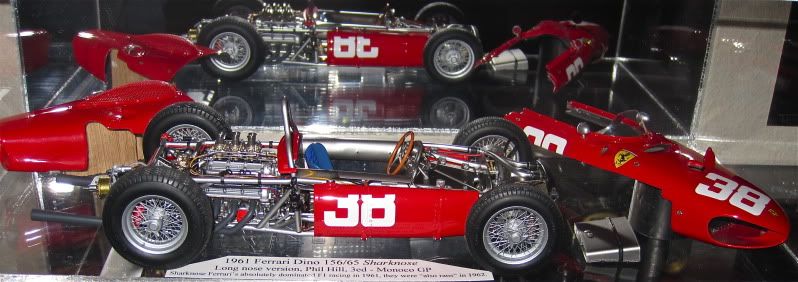
This exceptional Exoto model deserves a closeup.

In 1966 a sports car showed up that changed the face of the racing world - Jim Hall's Chaparral 2E. This car established the paradigm for virtually all racing cars built since. Within two years every sports racing car as well as formula one car had wings on tall struts, although many were not as well designed as the 2E's and the resulting accidents from their failures caused the high wings to be outlawed by the sanctioning bodies. The wings remained the struts did not.

The new lower cabinet contains six cars.
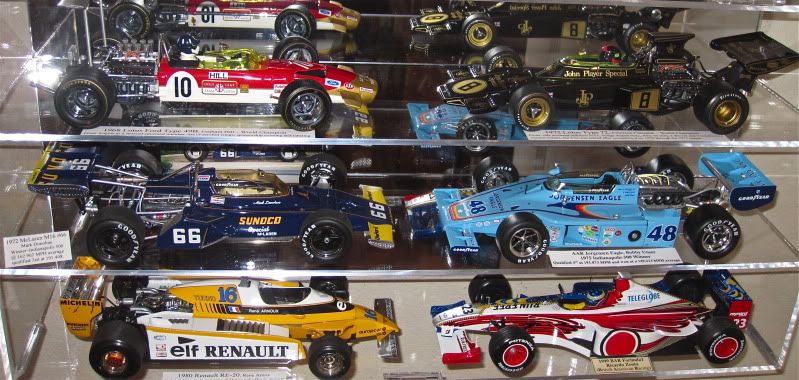
Note the tall wings which failed on several of the Lotus 49B's and also the traditional front mounted radiator. The Lotus 49 also was the first successful F1 car to use the engine as a structural member of the chassis.
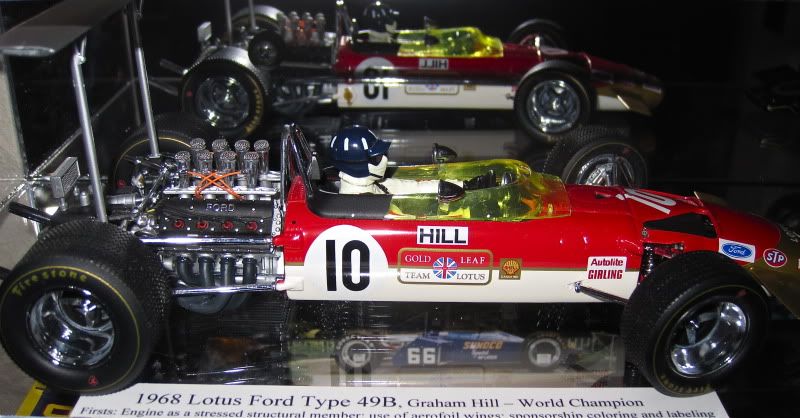
The Lotus 72 was another trend setting design. Other than having true ground effects the architecture of the modern F1 and Indy car had arrived.
Note the now traditional side mounted radiator, wings, and wedge shape.
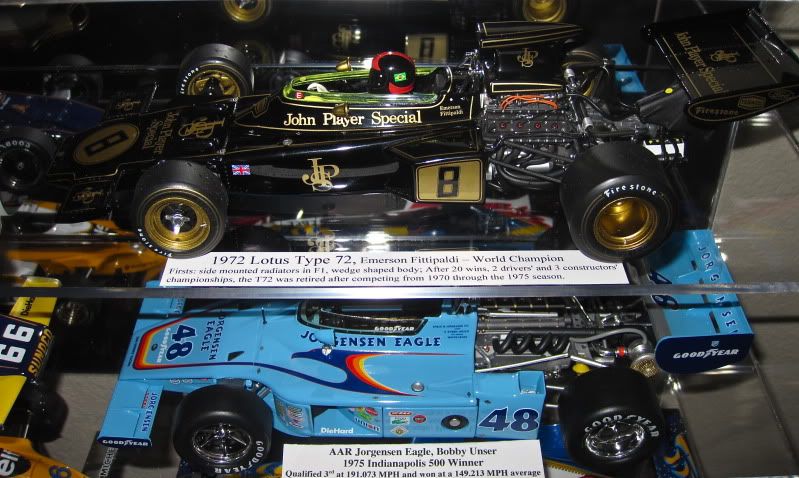
A better shot of the Lotus 72
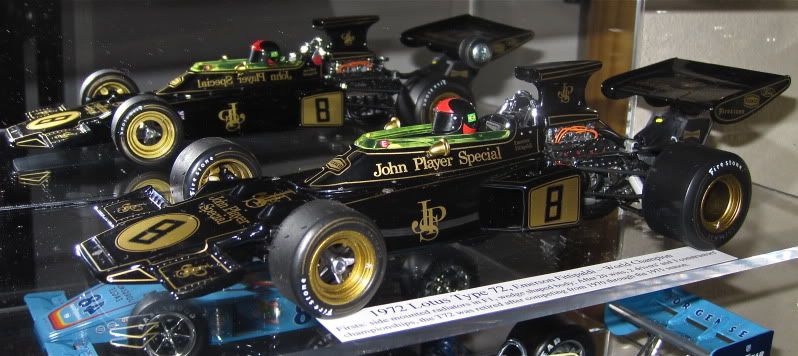
The McLaren Indy car was almost an exact copy of the Lotus 72. There is a picture of this car taken at the Indy Museum taped to the mirror behind the model.
The Renault below it was a full ground effects car with it's side pods forcing and keeping air flowing under the car's inverted airfoil under body which kept
it "glued" to the road especially during cornering. It also pioneered the Turbo technology that resulted in what was later called "the Turbo Era" in F1.

A little better shot

Gurney's Eagle fought it out with the McLaren for a number of years on America's tracks.
Below is a modern F1 car although it will be replaced when Vettel's Championship winning 2010 Red Bull becomes available.

I love this car because of it's dual paint job, each side completely different separated by a zipper down the middle. View the blue side in the mirror.
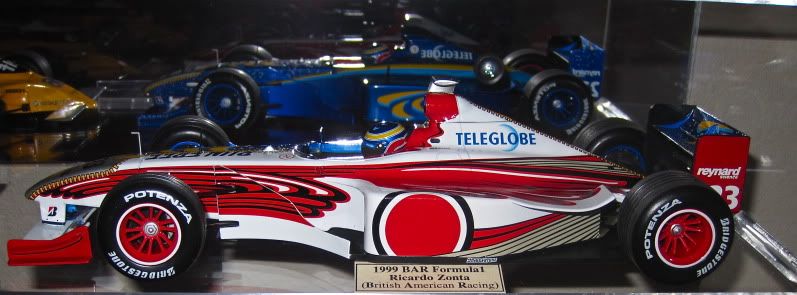
I hope you enjoyed the tour and the selection of racing cars whose contributions have influenced our every-day-drivers.
Cheers and Happy Collecting,
Steve |
Edited by - stewil on 12/16/2010 07:25:16 |
|
|
ferrari4evr1
USA
297 Posts |
 Posted - 12/13/2010 : 08:18:01 Posted - 12/13/2010 : 08:18:01


|
Steve, absolutely wonderful and diverse display of cars you have there. So many to look at and admire, one could spend hours in your office looking at the details and history of each model... Amazing collection you have...
Especially love the Exoto 156 -60 degree Phil Hill F1 car..... One of my favorites as well... Exoto took 1:18 details to a whole new level with that car...
James |
 |
|
|
stewil
USA
139 Posts |
 Posted - 12/16/2010 : 06:52:47 Posted - 12/16/2010 : 06:52:47


|
I thought you might also enjoy seeing these three important cars that would not fit into the display. I hope you are able to read the labels.
Ground effects creation
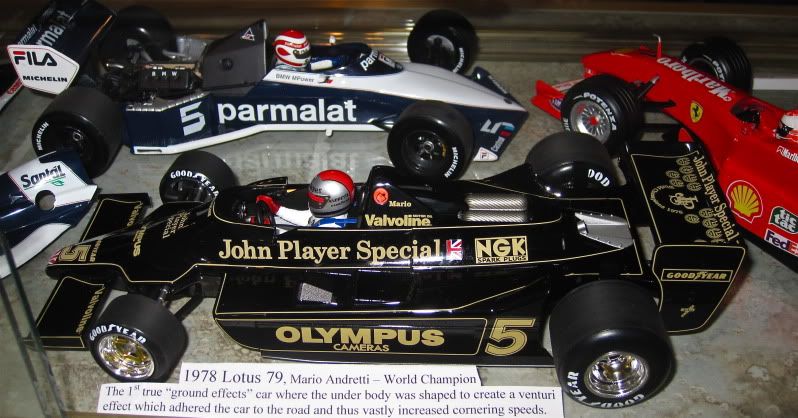
BIG Power here, the most ever in F1.

The most technologically advanced F1 car, whose technology since banned, but which made it's way into the cars we drive.

Cheers and Happy Collecting,
Steve |
Edited by - stewil on 12/16/2010 08:00:06 |
 |
|
|
ferrari4evr1
USA
297 Posts |
 Posted - 12/17/2010 : 07:45:11 Posted - 12/17/2010 : 07:45:11


|
Steve, who built your FW14B? Exoto?
The engine detail is superb!
James |
 |
|
|
stewil
USA
139 Posts |
 Posted - 12/17/2010 : 14:24:31 Posted - 12/17/2010 : 14:24:31


|
James,
Exoto was indeed the builder of the Williams, and it truly is superbly detailed.
Cheers and Happy Collecting,
Steve |
 |
|
| |
 Topic Topic  |
|
|
|
|
